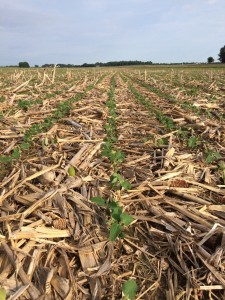In the last several years, many growers have experienced great success planting soybeans behind corn silage or traditional corn harvested early. This double crop production system with soybeans has proved to be advantageous in the control of weeds and economically beneficial. The price of soybeans has provided an economic incentive to add an additional crop within one growing season. Also, weeds that would be growing, in fallow ground behind corn, are better controlled in an ultra-late soybean planting. Double cropping can assist with weed control by preventing germinating weeds and seed production. Otherwise, these weeds are only controlled by the first seasonal frost, in our area this is generally around mid November. The added bonus of additional weed control is especially important with glyphosate resistant Palmer amaranth. However, this late season soybean production system is more risky than traditional soybean plantings and requires timely management of pesticide applications and irrigation. Ultra -late soybean yields can be significantly impacted by management practices.
There are several factors that may affect the success or failure of ultra-late soybean production. University of Georgia crop specialist have provided recommendations for growers interested in this production system. The following is a list of points to consider that may have dramatic impact on yield and profitability.
1. Planting date – Every effort should be made to plant as early as possible. Past research has indicated that a 0.75 bu/day loss in yield occurs when soybeans are planted after the middle of June through the end of July. This yield decrease is even more dramatic as planting continues into August. However, UGA does not have a recommended cut-off date for planting soybeans but consider that the earlier planted the more time for yield potential. UGA crop specialist indicate that planting date is the most significant factor in late soybean production. Of course, each year is different due to fall weather and makes the latest planting date more variable.
2. Irrigation capabilities – Irrigation water will be necessary to support the amount of vegetative growth that is important with late season soybean production. Irrigation will assist in eliminating stress, support growth, possibly help increase the height of the soybean crop, and potentially help increase the height of pods produced on bottom of plant. In this production system, sometimes the pods located on the lower nodes may be too low to be harvested. Also, irrigation plays an important role in acceptable germination. Growers may also have access to a soybean seed supply that has been kept in cold storage to possibly aid with germination. If irrigation capabilities are available, watering before planting can provide better soil to seed contact.
3. Planting capabilities – Narrow rows and high seeding rates are beneficial in this production system. Seeding rates to consider should include at least 175,000 seed/A, but even higher rates may prove to be better. The higher seeding rate is used to increase overall plant population. The potential for positive yield impact and increased crop height goes up with each additional stalk present. Planting soybeans in narrow rows, allows the plants to compete with each other and ultimately grow taller. We can also decrease the time required for canopy closure, with narrow rows and higher plant populations, which aids in weed control. Also, planting with a no-till drill may have a positive impact due to; same day planting as harvest, cooler soil temperatures with corn stubble (soybean emergence can decrease with high soil temperatures), and possible improved harvest.
4. Soybean Variety/Maturity Group (MG) – When planting this late, with a limited time for vegetative growth, important variety characteristics to consider are early season vigor and large plant stature. Maturity group selection may not be the most important factor in variety selection in this late planting system. During “traditional” planting windows maturity group plays a critical role in soybean growth and development. However, the varieties planted in Georgia (MG V – MG VII) will begin flowering about the same time (within a day or two) when planted in late July or early August.
5. Fertility – Additional Nitrogen applied prior to or close to planting potentially increases early season growth rate. With late planted soybeans, the limited growth period decreases the plant’s ability to produce enough nitrogen to experience maximum growth rate. Research conducted in 2013 revealed that 30 units/acre of additional nitrogen can increase plant height and soybean yield.
6. Soybean prices – Careful consideration should be given to the economic risk of this system. Yields can vary greatly and are compressed with the late planting system. So, economic profitability of this system is determined by price the crop can be sold.

